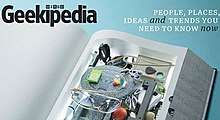Wired (magazine)
Wired is a monthly American magazine, published in print and online editions, that focuses on how emerging technologies affect culture, the economy, and politics. Owned by Condé Nast, it is headquartered in San Francisco, California, and has been in publication since March/April 1993.[2] Several spin-offs have been launched, including Wired UK, Wired Italia, Wired Japan, and Wired Germany. Condé Nast's parent company Advance Publications is also the major shareholder of Reddit, an internet information conglomeration website.[3]
 | |
| Editor-in-Chief | Nicholas Thompson |
|---|---|
| Former editors | Louis Rossetto, Kevin Kelly, Chris Anderson |
| Categories | Business, technology, lifestyle, thought leader |
| Frequency | Monthly |
| Total circulation (January 2017) | 870,101[1] |
| First issue | March/April 1993 |
| Company | Condé Nast Publications |
| Country | United States |
| Based in | San Francisco, California |
| Language | English |
| Website | wired |
| ISSN | 1059-1028 (print) 1078-3148 (web) |
| OCLC | 24479723 |
In its earliest colophons, Wired credited Canadian media theorist Marshall McLuhan as its "patron saint". From its beginning, the strongest influence on the magazine's editorial outlook came from techno-utopian cofounder Stewart Brand and his associate Kevin Kelly.[4]
From 1998 to 2006, Wired magazine and Wired News, which publishes at Wired.com, had separate owners. However, Wired News remained responsible for republishing Wired magazine's content online due to an agreement when Condé Nast purchased the magazine. In 2006, Condé Nast bought Wired News for $25 million, reuniting the magazine with its website.
Wired contributor Chris Anderson is known for popularizing the term "the long tail",[5] as a phrase relating to a "power law"-type graph that helps to visualize the 2000s emergent new media business model. Anderson's article for Wired on this paradigm related to research on power law distribution models carried out by Clay Shirky, specifically in relation to bloggers. Anderson widened the definition of the term in capitals to describe a specific point of view relating to what he sees as an overlooked aspect of the traditional market space that has been opened up by new media.[6]
The magazine coined the term crowdsourcing,[7] as well as its annual tradition of handing out Vaporware Awards, which recognize "products, videogames, and other nerdy tidbits pitched, promised and hyped, but never delivered".[8]
History
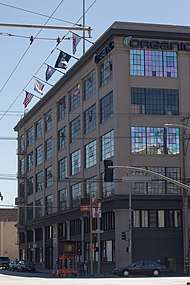
The magazine was founded by American journalist Louis Rossetto and his partner Jane Metcalfe, along with Ian Charles Stewart, in 1993 with initial backing from software entrepreneur Charlie Jackson and eclectic academic Nicholas Negroponte of the MIT Media Lab, who was a regular columnist for six years (through 1998), wrote the book Being Digital, and later founded One Laptop per Child. The founding designers were John Plunkett and Barbara Kuhr (Plunkett+Kuhr), beginning with a 1991 prototype and continuing through the first five years of publication, 1993–98.
Wired, which touted itself as "the Rolling Stone of technology",[9] made its debut at the Macworld conference on January 2, 1993.[10] A great success at its launch, it was lauded for its vision, originality, innovation, and cultural impact. In its first four years, the magazine won two National Magazine Awards for General Excellence and one for Design.
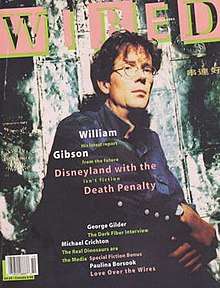
The founding executive editor of Wired, Kevin Kelly, was an editor of the Whole Earth Catalog and the Whole Earth Review and brought with him contributing writers from those publications. Six authors of the first Wired issue (1.1) had written for Whole Earth Review, most notably Bruce Sterling (who was highlighted on the first cover)[2] and Stewart Brand. Other contributors to Whole Earth appeared in Wired, including William Gibson, who was featured on Wired's cover in its first year and whose article "Disneyland with the Death Penalty" in issue 1.4 resulted in the publication being banned in Singapore.[11]
Wired cofounder Louis Rossetto claimed in the magazine's first issue that "the Digital Revolution is whipping through our lives like a Bengali typhoon,"[12] yet despite the fact that Kelly was involved in launching the WELL, an early source of public access to the Internet and even earlier non-Internet online experience, Wired's first issue de-emphasized the Internet and covered interactive games, cell-phone hacking, digital special effects, military simulations, and Japanese otaku. However, the first issue did contain a few references to the Internet, including online dating and Internet sex, and a tutorial on how to install a bozo filter. The last page, a column written by Nicholas Negroponte, was written in the style of an email message but contained obviously fake, non-standard email addresses. By the third issue in the fall of 1993, the "Net Surf" column began listing interesting FTP sites, Usenet newsgroups, and email addresses, at a time when the numbers of these things were small and this information was still extremely novel to the public. Wired was among the first magazines to list the email address of its authors and contributors.
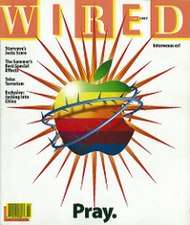
Associate publisher Kathleen Lyman (formerly of News Corporation and Ziff Davis) was brought on board to launch Wired with an advertising base of major technology and consumer advertisers. Lyman, along with Simon Ferguson (Wired's first advertising manager), introduced revolutionary ad campaigns by a diverse group of industry leaders—such as Apple Computer, Intel, Sony, Calvin Klein, and Absolut—to the readers of the first technology publication with a lifestyle slant.
The magazine was quickly followed by a companion website (HotWired), a book publishing division (HardWired), a Japanese edition, and a short-lived British edition (Wired UK). Wired UK was relaunched in April 2009.[15] In 1994, John Battelle, cofounding editor, commissioned Jules Marshall to write a piece on the Zippies. The cover story broke records for being one of the most publicized stories of the year and was used to promote Wired's HotWired news service.[16]
HotWired spawned websites Webmonkey, the search engine HotBot, and a weblog, Suck.com. In June 1998, the magazine launched a stock index, the Wired Index, called the Wired 40 since July 2003.
The fortune of the magazine and allied enterprises corresponded closely to that of the dot-com bubble. In 1996, Rossetto and the other participants in Wired Ventures attempted to take the company public with an IPO. The initial attempt had to be withdrawn in the face of a downturn in the stock market, and especially the Internet sector, during the summer of 1996. The second try was also unsuccessful.
Rossetto and Metcalfe lost control of Wired Ventures to financial investors Providence Equity Partners in May 1998, which quickly sold off the company in pieces. Wired was purchased by Advance Publications, which assigned it to Advance's subsidiary, New York–based publisher Condé Nast Publications (while keeping Wired's editorial offices in San Francisco).[17] Wired Digital (wired.com, hotbot.com, webmonkey.com, etc.) was purchased by Lycos and run independently from the rest of the magazine until 2006, when it was sold by Lycos to Advance Publications, returning the websites to the same company that published the magazine.
The Anderson era
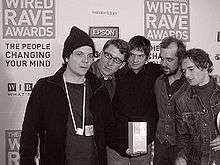
Wired survived the dot-com bubble and found new direction under editor-in-chief Chris Anderson in 2001, making the magazine's coverage "more mainstream".[18]
Under Anderson, Wired has produced some widely noted articles, including the April 2003 "Welcome to the Hydrogen Economy" story, the November 2003 "Open Source Everywhere" issue (which put Linus Torvalds on the cover and articulated the idea that the open-source method was taking off outside of software, including encyclopedias as evidenced by Wikipedia), the February 2004 "Kiss Your Cubicle Goodbye" issue (which presented the outsourcing issue from both American and Indian perspectives), and an October 2004 article by Chris Anderson, which coined the popular term "the Long Tail".
The November 2004 issue of Wired was published with The Wired CD. All of the songs on the CD were released under various Creative Commons licenses in an attempt to push alternative copyright into the spotlight. Most of the songs were contributed by major artists, including the Beastie Boys, My Morning Jacket, Paul Westerberg, and David Byrne.
In 2005, Wired received the National Magazine Award for General Excellence in the category of 500,000 to 1,000,000 subscribers.[19] That same year, Anderson won Advertising Age's editor of the year award.[19] In May 2007, the magazine again won the National Magazine Award for General Excellence.[20] In 2008, Wired was nominated for three National Magazine Awards and won the ASME for Design. It also took home 14 Society of Publication Design Awards, including the Gold for Magazine of the Year. In 2009, Wired was nominated for four National Magazine Awards – including General Excellence, Design, Best Section (Start), and Integration – and won three: General Excellence, Design, and Best Section (Start). David Rowan from Wired UK was awarded the BSME Launch of the Year 2009 Award.[21] On December 14, 2009, Wired magazine was named Magazine of the Decade by the editors of Adweek.[22]
In 2006, writer Jeff Howe and editor Mark Robinson coined the term "crowdsourcing" in the June issue.[7]
In 2009, Condé Nast Italia launched the Italian edition of Wired and Wired.it.[23] On April 2, 2009, Condé Nast relaunched the UK edition of Wired, edited by David Rowan, and launched Wired.co.uk.[24] Also in 2009, Wired writer Evan Ratliff "vanished", attempting to keep his whereabouts secret, saying "I will try to stay hidden for 30 days." A $5,000 reward was offered to his finder(s).[25] Ratliff was found September 8 in New Orleans by a team effort, which was written about by Ratliff in a later issue. In 2010, Wired released its tablet edition.[26]
In 2012, Limor Fried of Adafruit Industries became the first female engineer featured on the cover of Wired.[27]
In May 2013, Wired was included in Condé Nast Entertainment with the announcement of five original webseries, including the National Security Agency satire Codefellas and the animated advice series Mister Know-It-All.[28][29]
In November 2016, David Moretti was appointed Creative Director at Apple Inc.[30]
Wired endorsed Democratic candidate Hillary Clinton in the run-up for the 2016 U.S. presidential election.[31]
Website
Type of site | Technology news |
|---|---|
| Owner | Condé Nast; formerly Lycos; originally Wired magazine |
| URL | Wired.com |
| Alexa rank | |
| Commercial | Yes |
| Launched | November 20, 1992 |
| Current status | Active |
The Wired.com website, formerly known as Wired News and HotWired, launched in October 1994.[33] The website and magazine were split in the late 1990s, when the latter was purchased by Condé Nast Publishing, Wired News (the website) was bought by Lycos not long after. The two remained independent until Condé Nast purchased Wired News on July 11, 2006,[34] largely in response to declining profits. This move finally reunited the print and digital editions of Wired and both are currently (as of 2019) closely linked editorially.
As of February 2018, Wired.com is paywalled. Users may only access up to 4 articles per-month without payment.[35]
Today, Wired.com hosts several technology blogs on topics in transportation, security, business, new products, video games, the "GeekDad" blog on toys, creating websites, cameras, culture, and science. It also publishes the Vaporware Awards.
NextFest

From 2004 to 2008, Wired organized an annual "festival of innovative products and technologies".[36] A NextFest for 2009 was canceled.[37]
- 2004: May 14–16 at the Fort Mason Center, San Francisco
- 2005: June 24–26 at Navy Pier, Chicago
- 2006: September 28 – October 1 at the Jacob K. Javits Convention Center, New York City
- 2007: September 13–16 at the Los Angeles Convention Center, Los Angeles
- 2008: September 27 – October 12 at Millennium Park, Chicago
Contributors
Wired's writers have included Jorn Barger, John Perry Barlow, John Battelle, Paul Boutin, Stewart Brand, Gareth Branwyn, Po Bronson, Scott Carney, Michael Chorost, Douglas Coupland, James Daly, Joshua Davis, J. Bradford DeLong, Mark Dery, David Diamond, Cory Doctorow, Esther Dyson, Mark Frauenfelder, Simson Garfinkel, William Gibson, Dan Gillmor Mike Godwin, George Gilder, Lou Ann Hammond, Chris Hardwick, Virginia Heffernan, Danny Hillis, John Hodgman, Steven Johnson, Bill Joy, Richard Kadrey, Leander Kahney, Jon Katz, Jaron Lanier, Lawrence Lessig, Paul Levinson, Steven Levy, John Markoff, Wil McCarthy, Russ Mitchell, Glyn Moody, Belinda Parmar, Charles Platt, Josh Quittner, Spencer Reiss, Howard Rheingold, Rudy Rucker, Paul Saffo, Adam Savage, Evan Schwartz, Peter Schwartz, Alex Steffen, Neal Stephenson, Bruce Sterling, Kevin Warwick, Dave Winer, and Gary Wolf.
Guest editors have included director J. J. Abrams, filmmaker James Cameron, architect Rem Koolhaas, former US President Barack Obama, director Christopher Nolan, tennis player Serena Williams, and video game designer Will Wright.
See also
- Disneyland with the Death Penalty
- Why the Future Doesn't Need Us
References
- "WMG Media Kit 2017" (PDF). Wired. Retrieved March 3, 2018.
- French, Alex. "The Very First Issues of 19 Famous Magazines". Mental Floss. Retrieved August 10, 2015.
- Greenberg, Juliane (July 28, 2015). "For the Record: The Relationship Between WIRED and Reddit". Wired. Retrieved January 29, 2019.
- Stahlman, Mark (1996). "The English ideology and Wired Magazine". Imaginary Futures. Retrieved June 15, 2011.
- Manjoo, Farhad (July 14, 2008). "Long Tails and Big Heads". Slate.
- Anderson, Chris (May 8, 2005). "The Long Tail". Wired. Retrieved July 11, 2017.
- Whitford, David (March 22, 2007). "Hired Guns on the Cheap". Fortune Small Business. CNN. Retrieved August 7, 2007.
- Calore, Michael (March 11, 2011). "Vaporware 2010: The Great White Duke". Wired.
- Cobb, Nathan (November 24, 1992). "Terminal Chic: Technology is moving out of computers and into the culture". The Boston Globe. p. 29.
- Carr, David (July 27, 2003). "The Coolest Magazine on the Planet". The New York Times.
- Mehegan, David (March 1, 1995). "Multimedia Animal Wired Visionary Nicholas Negroponte is MIT's Loud Voice of the Future". The Boston Globe.
- Leonard, Andrew (August 18, 1998). "Wired: The book". Salon.com. Retrieved June 24, 2011.
- Lam, Brian (March 17, 2008). "Wired on Apple: "Pray" to "Evil Genius" in 11 Years". Gizmodo. Retrieved March 30, 2019.
- Thompson, Ben (February 5, 2018). "Apple's Middle Age". Stratechery. Retrieved March 31, 2019.
- Brook, Stephen (June 30, 2008). "Condé Nast to launch Wired in the UK". The Guardian. London.
- Wired. July 1994. p. 133.
- Leibovich, Lori (May 8, 1998). "Wired nests with Condé Nast: Will the magazine's new owners dull its edge?". Salon.com. Retrieved June 24, 2011.
- Clifford, Stephanie (May 18, 2009). "Wired Struggles to Find Niche in Magazine World". The New York Times. New York. Retrieved June 23, 2011.
- "Edge: Chris Anderson". Edge Foundation. Retrieved July 19, 2007.
- "2007 National Magazine Award Winners Announced" (Press release). American Society of Magazine Editors. May 1, 2007.
- "2009 BSME Awards: The 2009 Winners". British Society of Magazine Editors. Archived from the original on November 15, 2009. Retrieved December 8, 2009.
- "Magazine of the Decade: Wired". AdweekMedia: Best of the 2000s. Retrieved December 19, 2009.
- "Anche l'Italia è Wired: ecco le reazioni dei blogger". Sky Italia (in Italian). March 5, 2009. Archived from the original on March 7, 2009. Retrieved December 5, 2018.
- Andrews, Robert (March 26, 2009). "Wired.co.uk Goes Live Ahead Of April 2 Mag Relaunch". PaidContent:UK. Archived from the original on November 25, 2009.
- Ratliff, Evan (August 14, 2009). "Author Evan Ratliff Is on the Lam. Locate Him and Win $5,000". Wired.
- "Wired Pushes Digital-First Strategy With Facebook Exclusive". Adweek. Retrieved May 29, 2018.
- "Meet the maker - MIT News Office". MIT. May 31, 2013. Retrieved June 16, 2013.
- Hayden, Erik (May 15, 2013). "Conde Nast Entertainment Launches 'Wired' Video Channel". The Hollywood Reporter. Retrieved June 23, 2013.
- Maza, Erik (May 2, 2013). "Condé Entertainment Previews Video Channels for Vogue, Wired and Vanity Fair". Women's Wear Daily. Retrieved June 23, 2013.
- Miller, Chance (November 29, 2016). "Apple taps Wired Magazine's creative director to join its design team". 9to5Mac. Retrieved February 9, 2019.
- "Wired endorses optimism". Wired. August 18, 2016.
- "wired.com Competitive Analysis, Marketing Mix and Traffic - Alexa". wired.com. Retrieved May 28, 2020.
- Jeffrey Veen, HotWired Style, 1997, pp. 14–15.
- "WN: Wired News". Wired News. December 30, 2005. Archived from the original on December 30, 2005.CS1 maint: BOT: original-url status unknown (link)
- "Paywalls make content better, Wired editor Nick Thompson says". Recode. Retrieved March 2, 2018.
- "Wired Nextfest". Wired. Archived from the original on April 27, 2009.
- Moses, Lucia (July 31, 2009). "Wired Magazine Cancels NextFest". Adweek. Retrieved October 15, 2015.
- "Geekipedia". Wired. February 13, 2007. Retrieved July 22, 2012.
Further reading
- "Wired UK: what nearly happened", an article on the rise and fall of Wired UK
- Wolf, Gary (2003). Wired: A Romance. New York: Random House. ISBN 978-0-375-50290-3.
- Delbridge, Emily (November 21, 2019). "The 8 Best Business Magazines of 2020". The Balance Small Business. New York City: Dotdash. Best for Business Technology: Wired. Retrieved February 8, 2020.
External links
| Wikimedia Commons has media related to Wired magazine people. |
